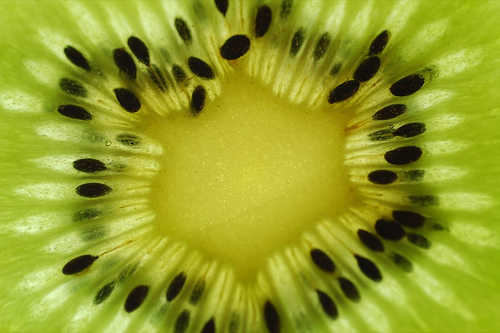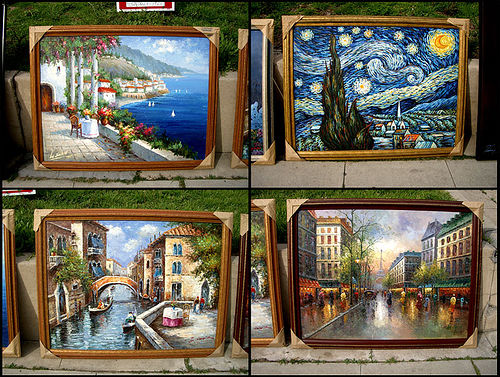Some cool import kitchen from china images:
Fruit/Star

Image by aka*Travz
The kiwifruit (or kiwi) is the edible berry of a cultivar group of the woody vine Actinidia deliciosa and hybrids between this and other species in the genus Actinidia. The Actinidia is native to Shaanxi, China.
The most common cultivars of kiwifruit are oval, about the size of a large hen’s egg (5–8 cm / 2–3 in long and 4.5–5.5 cm / 1¾–2 in diameter). It has a fibrous, dull green-brown skin and bright green or golden flesh with rows of small, black, edible seeds. The fruit has a soft texture and a unique flavour.
Originally known as the Chinese Gooseberry, the fruit was renamed for marketing reasons in the mid-20th century, first to melonette, and then to kiwifruit. The latter name was chosen for the indigenous New Zealand bird, kiwi, which is one of the country’s national symbols. The first renaming was done in order to avoid a tariff on melons imported into the US. It is not uncommon outside New Zealand and Australia for the fruit to be referred to simply as "kiwi". Today, kiwifruit is a commercial crop in several countries.
Kiwifruit is a rich source of vitamin C, 1.5 times the DRI scale in the US. Its potassium content by weight is slightly less than that of a banana. It also contains vitamins A and E. The skin is a good source of flavonoid antioxidants. The kiwifruit seed oil contains on average 62% alpha-linolenic acid, an omega-3 fatty acid. Usually a medium size kiwifruit contains about 46 kilocalories, 0.3-gram fats, 1 gm proteins, 11 gm carbohydrates, 75 mg vitamins and 2.6 grams dietary fiber.
Kiwifruit is often reported to have mild laxative effects, possibly because of the high level of dietary fibre.
Raw kiwifruit is also rich in the protein-dissolving enzyme actinidin, (in the same family of thiol proteases as papain), which is commercially useful as a meat tenderizer but can be an allergen for some individuals. Specifically, people allergic to latex, papayas or pineapples are likely to be allergic to kiwifruit also. Reactions include tingling and sore mouth; swelling of the lips, tongue and face; rash; vomiting and abdominal pain; and, in the most severe cases, breathing difficulties, wheezing and collapse. The most common symptoms are unpleasant itching and soreness of the mouth, with the most common severe symptom being wheezing. Severe symptoms are most likely to occur in young children.
This enzyme makes raw kiwifruit unsuitable for use in desserts containing milk or any other dairy products which are not going to be served within hours, because it soon begins to digest milk proteins. This applies to gelatin-based desserts as well, as the actinidin will dissolve the collagen proteins in gelatin very quickly, either liquifying the dessert, or preventing it from solidifying. However, the U.S. Department of Agriculture suggests that cooking the fruit for a few minutes before adding it to the gelatin will overcome this effect. Sliced kiwifruit has long been regularly used as a garnish atop whipped cream on one of New Zealand and Australia’s favourite dessert, the pavlova.
Kiwifruit also serves as a natural blood thinner. A recent study performed at the University of Oslo in Norway reveals that–similar to popular mainstream aspirin therapy-consuming two to three kiwifruit daily for 28 days significantly thins the blood, reducing the risk of clots, and lowers fat in the blood that can cause blockages.
Thank you Wikipedia.org for the information about kiwifruit!
chinese-art

Image by 7-how-7
walking down the street today, i spied these fine artworks and stopped to talk to the guy selling them. he told me he was getting out of the biz, and would let these go real cheap. i asked if they were his work, and he said no, they were all imported from china, and explained that they have huge factory/studios over there where all day long people turn out canvas after canvas of european style schlock painting. i was intrigued. I asked about the signature, which were names like "Douglas" and "Watson" (the van gogh was signed something like "Ferrers") He said the signature was one of the most important parts, and that similar paintings without the signatures didn’t sell as well. He said that invididual artists in these studios didn’t sign their painting with their own individual (fake) signature, but rather every painter in a certain studio may sign as "Winston" and in another studio all the artists might use the signature "Avery", etc…While i was talking to him a couple pulled over and bought the "Ferrers Van Gogh" for .00 ( "Normally it would be 9.00," he explained, "but since i’m getting out of the business, i’m giving ’em away."